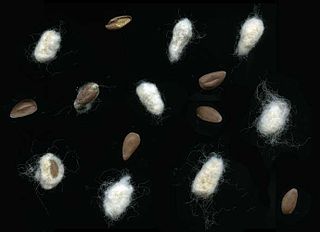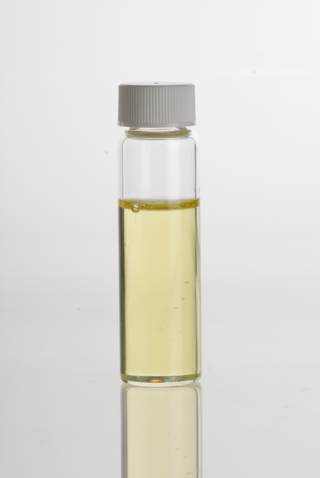Perfume is a mixture of fragrant essential oils or aroma compounds (fragrances), fixatives and solvents, usually in liquid form, used to give the human body, animals, food, objects, and living-spaces an agreeable scent. Perfumes can be defined as substances that emit and diffuse a pleasant and fragrant odor. They consist of manmade mixtures of aromatic chemicals and essential oils. The 1939 Nobel Laureate for Chemistry, Leopold Ružička stated in 1945 that "right from the earliest days of scientific chemistry up to the present time, perfumes have substantially contributed to the development of organic chemistry as regards methods, systematic classification, and theory."

Vegetable oils, or vegetable fats, are oils extracted from seeds or from other parts of fruits. Like animal fats, vegetable fats are mixtures of triglycerides. Soybean oil, grape seed oil, and cocoa butter are examples of seed oils, or fats from seeds. Olive oil, palm oil, and rice bran oil are examples of fats from other parts of fruits. In common usage, vegetable oil may refer exclusively to vegetable fats which are liquid at room temperature. Vegetable oils are usually edible.

An essential oil is a concentrated hydrophobic liquid containing volatile chemical compounds from plants. Essential oils are also known as volatile oils, ethereal oils, aetheroleum, or simply as the oil of the plant from which they were extracted, such as oil of clove. An essential oil is essential in the sense that it contains the essence of the plant's fragrance—the characteristic fragrance of the plant from which it is derived. The term "essential" used here does not mean indispensable or usable by the human body, as with the terms essential amino acid or essential fatty acid, which are so called because they are nutritionally required by a living organism.

Cottonseed oil is cooking oil from the seeds of cotton plants of various species, mainly Gossypium hirsutum and Gossypium herbaceum, that are grown for cotton fiber, animal feed, and oil.
Carrier oil, also known as base oil or vegetable oil, is used to dilute essential oils and absolutes before they are applied to the skin in massage and aromatherapy. They are so named because they carry the essential oil onto the skin at a safe concentration. Diluting essential oils is a critical safety practice when using essential oils. Essential oils alone are volatile; they begin to dissipate as soon as they are applied. The rate of dispersion varies based on factors such as viscosity, vapour pressure, and the molecular weight of the volatile components. Carrier oils do not contain a concentrated aroma, unlike essential oils, though some, such as olive, have a mild distinctive smell. Neither do they evaporate like essential oils, which are more volatile. The carrier oils used should be as natural and unadulterated as possible. Many people feel organic oils are of higher quality. Cold-pressing and maceration are the two main methods of producing carrier oils.

Used in perfumery and aromatherapy, absolutes are similar to essential oils. They are concentrated, highly aromatic, oily mixtures extracted from plants. Whereas essential oils are produced by distillation, boiling or pressing, absolutes are produced through solvent extraction, or more traditionally, through enfleurage.

Sesame oil is an edible vegetable oil derived from sesame seeds. The oil is one of the earliest-known crop-based oils. Worldwide mass modern production is limited due to the inefficient manual harvesting process required to extract the oil. Oil made from raw seeds, which may or may not be cold-pressed, is used as a cooking oil. Oil made from toasted seeds is used for its distinctive nutty aroma and taste, although it may be unsuitable for frying, which makes it taste burnt and bitter.

Steam distillation is a separation process that consists in distilling water together with other volatile and non-volatile components. The steam from the boiling water carries the vapor of the volatiles to a condenser; both are cooled and return to the liquid or solid state, while the non-volatile residues remain behind in the boiling container.
Fragrance oils, also known as aroma oils, aromatic oils, and flavor oils, are blended synthetic aroma compounds or natural essential oils that are diluted with a carrier like propylene glycol, vegetable oil, or mineral oil.

Expeller pressing is a mechanical method for extracting oil from raw materials. The raw materials are squeezed under high pressure in a single step. When used for the extraction of food oils, typical raw materials are nuts, seeds and algae, which are supplied to the press in a continuous feed. As the raw material is pressed, friction causes it to heat. In the case of harder nuts the material can exceed temperatures of 120 °F (49 °C).

Rose oil is the essential oil extracted from the petals of various types of rose. Rose ottos are extracted through steam distillation, while rose absolutes are obtained through solvent extraction, the absolute being used more commonly in perfumery. The production technique originated in Greater Iran. Even with their high price and the advent of organic synthesis, rose oils are still perhaps the most widely used essential oil in perfumery.

Sunflower oil is the non-volatile oil pressed from the seeds of the sunflower. Sunflower oil is commonly used in food as a frying oil, and in cosmetic formulations as an emollient.

Fragrance extraction refers to the separation process of aromatic compounds from raw materials, using methods such as distillation, solvent extraction, expression, sieving, or enfleurage. The results of the extracts are either essential oils, absolutes, concretes, or butters, depending on the amount of waxes in the extracted product.

A florentine flask, also known as florentine receiver, florentine separator or essencier, other shapes called florentine vase or florentine vessel, is an oil–water separator fed with condensed vapors of a steam distillation in a fragrance extraction process.
Mango oil, mango kernel fat, or mango butter, is an oil fraction obtained during the processing of mango butter. Mango oil is a seed oil extracted from the stone of the mango, the fruit of the Mangifera indica tree. The oil is semi-solid at room temperatures, but melts on contact with warm skin, making it appealing for baby creams, suncare balms, hair products, and other moisturizing products. The oil is a soft yellow color with a melting point of 32–42 °C (90–108 °F).

Vegetable oil is a liquid derived from plants. These are triglyceride-based, and includes cooking oils like sunflower oil, solid oils like cocoa butter, oils used in paint like linseed oil and oils for industrial purposes, including as biofuels.

An oil mill is a grinding mill designed to crush or bruise oil-bearing seeds, such as linseed or peanuts, or other oil-rich vegetable material, such as olives or the fruit of the oil palm, which can then be pressed to extract vegetable oils, which may used as foods or for cooking, as oleochemical feedstocks, as lubricants, or as biofuels. The pomace or press cake – the remaining solid material from which the oil has been extracted – may also be used as a food or fertilizer.

Cooking oil is a plant or animal liquid fat used in frying, baking, and other types of cooking. Oil allows higher cooking temperatures than water, making cooking faster and more flavorful, while likewise distributing heat, reducing burning and uneven cooking. It sometimes imparts its own flavor. Cooking oil is also used in food preparation and flavoring not involving heat, such as salad dressings and bread dips.












